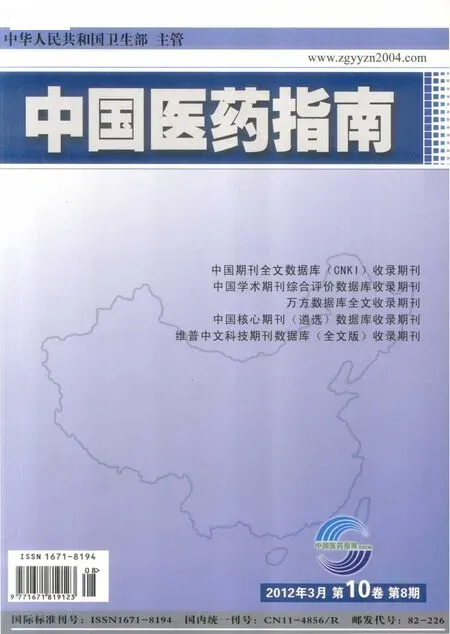头颈部鳞状细胞癌靶向治疗的研究进展
伍立德
(万州区第五人民医院耳鼻咽喉科,重庆 404000)
靶向治疗的临床应用将头颈鳞状细胞癌(head and neck squamous cell carcinoma,SCCHN)的治疗带入了一个新纪元。目前,新型的靶向治疗途径主要通过上皮生长因子受体(Epidermal Growth Factor Receptor,EGFR),血管内皮生长因子 (vascular endothelial growth factor,VEGF),核因子κB(nuclear factor kappa B,NF-ΚB),胰岛素样生长因子受体(insulin-like growth factor receptor,IGFR)和p53等途径。本文对近年SCCHN靶向治疗中的主要药物应用及新进展做简要综述。
1 EGFR途径
EGFR是ErbB跨膜糖蛋白受体家族成员之一。Mendelsohn等(2003)发现在头颈部肿瘤中,EGFR信号通路途径被异常激活。EGFR单克隆抗体包括:
1.1 西妥昔单抗
西妥昔(Cetuximab)(IMC-C225)是一种嵌合型抗体,它能够与EGFR细胞内区域结合,引起EGFR的二聚化并内陷入细胞引起表达下调。目前研究已经证实西妥昔单抗能够增加RT的有效性,特别是在治疗局部进展的SCCHN和以顺铂为基础的化学治疗方案治疗转移的SCCHN患者中[1,2]。Bonner等(2006)发现对于局部进展的SCCHN患者给予西妥昔联合RT治疗比单独应用RT方案的患者中位总生存数(overall survival,OS)有明显改善。
1.2 Panitumuma
Panitumumab是一种具有高亲和性的人源性EGFR的单克隆抗体。目前对于Panitumuma有许多临床实验,其中有CONCERT2 II期临床试验主要研究Panitumuma联合化学放射治疗(chemoradiotherapy,CRT)或RT治疗局部进展性SCCHN的疗效[3]。
2 小分子EGFR-TKIs
EGFR酪氨酸激酶抑制剂(tyrosine kinase inhibitors,TKIs)主要通过与ATP竞争性可逆的与EGFR-TK细胞内催化区域结合而抑制EGFR的自身磷酸化以及下游的信号通路。
2.1 吉非替尼(Gefitinib)
吉非替尼(Gefitinib)是第一个口服起效的选择性小分子EGFRTKI。Cohen等(2003)在一次II期临床实验中通过观察缓解数(complete remission,CR),部分缓解数(partial remission,PR)发现以足量的Gefitinib(500mg/天)治疗SCHNN得到的疾病控制率为53%,而中位生存数约8个月。Argiris等[4]发现联合应用多西他赛和Gefitinib能够明显改善疾病进展时间(time to progression,TTP)但是对于复发和转移的SCCHN患者生存率的提高并不明显。
2.2 埃罗替尼(Erlotinib)
埃罗替尼(Erlotinib)是一种口服的可逆性EGFR-TKI。Pollack 等(1999)发现在异种移植人SCCHN细胞系的小鼠体内,Erlotinib单独应用或联合顺铂应用均有抗肿瘤活性。Hidalgo等(1999)在II期实验中发现,Erlotinib能够应用于曾经接受过治疗的SCCHN患者,并且能够使38%的病例病情稳定,而中位数持续时间约16.1周。
2.3 拉帕替尼(Lapatinib)
拉帕替尼(Lapatinib)是一种新型高选择性的EGFR 和 ErbB2 TKs抑制剂,对于许多实质肿瘤均有抑制作用。Bourhis等通过观察31名应用Lapatinib(1500mg/天)联合化学治疗和RT方案治疗的患有局部进展SCCHN患者,发现总体的反应率为100%,CR为74%(n=14),PR为26%(n=5)[5]。
3 VEGF途径
Ferrara 等(2001)发现VEGF家族能够通过与细胞表面的TK受体结合刺激其二聚化并且通过转磷酸化而激活受体,因此抗血管生成治疗已经成为实质肿瘤的治疗中的重要方案。
3.1 贝伐单抗(Bevacizumab)
贝伐单抗(Bevacizumab)是VEGF的单克隆抗体,具有抗SCCHN的作用。在SCCHN患者中发现VEGF水平明显升高,并且表现出促进肿瘤生长转移以及对治疗的抵抗现象,而血管生成抑制剂复合物表现出放射增敏性、充氧作用以及抗肿瘤效果[6]。
3.2 舒尼替尼(Sunitinib)
舒尼替尼(Sunitinib)是一种多选择性的TKI。 Choong等在II期临床实验中发现Sunitinib在ECOG PS评分0或1的肿瘤患者中,药物应答率(response rate ,RR)为8%。在ECOG PS评分为2的患者中,没有发现治疗反应[7]。Machiels等[8]在 I期临床实验中给予38名顺铂治疗失败的肿瘤患者连续6周的舒尼替尼(37.5mg/天),发现中位无进展生存时间(progression-free survival,PFS)为60d,中位OS为102d。
3.3 西地尼布(Cediranib)
西地尼布(Cediranib)是一种新型高效的口服型VEGF信号通路抑制剂。近期有临床试验发现在15名应用西地尼布SCCHN患者中有3人达到PR,但是实验过程中患者出现了不同程度的蛋白尿、乏力、出血等药物毒性反应[9]。
4 蛋白酶体抑制剂与NF-κB途径
泛素-蛋白酶体途径能够促进细胞周期调节、凋亡、炎症、免疫反应等多种细胞生物过程中蛋白的降解[10]。硼替佐米(Bortezomib)是第一个临床开发的作为抗肿瘤药物的蛋白酶体抑制剂。研究表明Bortezomib能够阻断NF-kB的激活,抑制细胞增殖,促进SCCHN细胞系的凋亡,并且对于人SCCHN异种移植实验模型有抑制肿瘤生长,改善抗放射性和抗血管生成的作用[11]。
5 IFG受体途径
IGFG-1R是一种具有TK活性的细胞跨膜受体。近期研究发现SCCHN中IGF-1R存在过表达[12,13]。IGF-1R的过表达能够促进细胞生长、抑制细胞凋亡,并且引起细胞对于化学治疗、生物抗肿瘤治疗的抵抗性。IGF-1R的抑制剂有Figitumumab、Cixutumumab(IMC-A12)、AMG-479等。
6 p53途径
p53基因在细胞DNA修复、细胞周期、凋亡、衰老中均发挥重要作用。Advexin (INGN201/AdCMV-p53)能够携带野生型P53基因进入细胞,引起细胞生长停止、凋亡,抑制肿瘤生长。Goodwin等(1999)在II期多中心试验中观察了接受肿瘤内advexin治疗的112名患有复发或无法切除的SCCHN患者,其中16%的患者中位生存率达到10.2个月。
7 结 语
目前SCCHN治疗方面,许多新型分子的开发与临床实验在进行中。新型的单克隆抗体如panitumumab、VEGF抑制剂等在治疗SCCHN患者中均显示出了潜在的治疗效果。但是与之相伴随地,许多药物毒副作用的问题也浮现出来。因此对于靶向治疗SCCHN患者药物的安全性和有效应仍有待于进一步的研究和提高。
[1]Burtness B,Goldwasser MA,Flood W,et al.Phase III randomized trial of cisplatin plus placebo compared with cisplatin plus cetuximab in metastatic/recurrent head and neck cancer:an Eastern Cooperative Oncology Group study[J].J Clin Oncol,2005,23(34),8646–8654.
[2]Vermorken JB,Trigo J,Hitt R,et al.Open-label,uncontrolled,multicenter Phase II study to evaluate the efficacy and toxicity of cetuximab as a single agent in patients with recurrent and/or metastatic squamous cell carcinoma of the head and neck who failed to respond to platinumbased therapy[J].J Clin Oncol,2007,25(16):2171–2177.
[3]Burgos-Tiburcio A,Santos ES,Arango BA,et al.Development of targeted therapy for squamous cell carcinomas of the head and neck[J].Expert Rev Anticancer Ther,2011,11(3):373–386.
[4]Argiri S,Ghebremichael M,Gilbert J,et al.A Phase III randomized,placebo-controlled trial of docetaxel (D)with or without gefitinib(G)in recurrent or metastatic (R/M)squamous cell carcinoma of the head and neck(SCCHN),a trial of the Eastern Cooperative Oncology Group (ECOG)[J].J Clin Oncol,2009,27 (15S):6011.
[5]Harrington K,El-Hariry I,Bourhis J,et al.Phase I study of lapatinib in combination with chemoradiation in patients with locally advanced squamous cell carcinoma of the head and neck[J].J Clin Oncol,2009,27(7):1100–1107.
[6]Wachsberger PR,Dicker AP.Tumor response to ionizing radiation combined Burd with antiangiogenesis or vascular targeting agents:exploring mechanisms of interaction[J].Clin Cancer Res,2003,9(6):1957–1971.
[7]Choong NW,Cohen EE,Kozloff MF,et al.Phase II trial of sunitinib in patients with recurrent and/or metastatic squamous cell carcinoma of the head and neck (SCCHN)[J].J Clin Oncol,2008,26(15S):332s.
[8]Machiels H,Henry S,Zanetta S,et al.Phase II Study of sunitinib in recurrent or metastatic squamous cell carcinoma of the head and neck: GORTEC 2006-01[J].J Clin Oncol,2009,27(15S):6024.
[9]Saura C,Baselga J,Herbst R,et al.Antitumor activity of cediranib in patients with metastatic or recurrent head and neck cancer (HNC)or recurrent non-small cell lung cancer (NSCLC).An open-label exploratory study[J].J Clin Oncol,2009,27(15S):6023.
[10]Roccaro AM,Hideshima T,Richardson PG,et al.Bortezomib as an antitumor agent[J].Curr Pharm Biotechnol,2006,7(6):441-448.
[11]Lun M,Zhang PL,Pellitteri PK,et al.Nuclear factor-kB pathway as a therapeutic target in head and neck squamous cell carcinoma:pharmaceutical and molecular validation in human cell lines using Velcade and siRNA/NFkB[J].Ann Clin Lab Sci,2005,35(2);251-258.
[12]Barnes CJ,Ohshiro K,Rayala SK,et al.Insulin-like growth factor receptor as a therapeutic target in head and neck cancer[J].Clin Cancer Res,2007,13(14): 4291–4299 .
[13]Slomainy MG,Black LA,Kibbey MM,et al.Rosenzweig SA.Insulinlike growth factor-1 receptor and ligand targeting in head and neck squamous cell carcinoma[J].Cancer Lett,2007,248(2):269-279.

